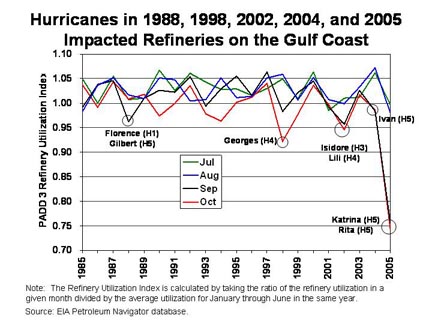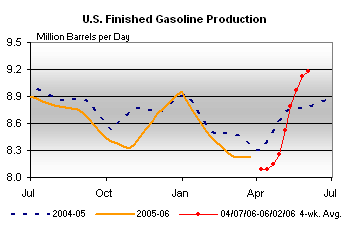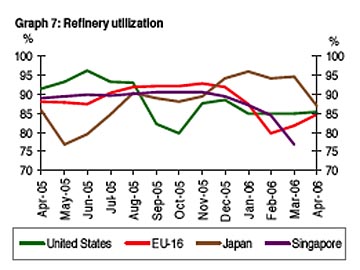Hurricanes and Sand Storms, some thoughts on the coming months
Posted by Heading Out on June 8, 2006 - 10:30am

At present they are accepting the NOAA forecast that this year will be above normal, but not as bad as last year, however, as they note:
Based on NOAA's May 2006 projections for the 2006 hurricane season and the historical relationship between tropical storm activity and production disruptions between 1960 and 2005, total reductions in crude oil and natural gas production from the Gulf of Mexico OCS due to tropical storm activity in 2006 are expected to range from 0 to 35 million barrels and 0 to 206 billion cubic feet, respectively. NOAA emphasizes that its May hurricane outlook is based on climatological conditions that are still evolving. An updated hurricane outlook will be issued in August, when conditions favorable for hurricanes are more predictable. There is a possibility that NOAA could substantially revise its projections for seasonal hurricane activity, as in 2005, when the May outlook, projecting hurricane activity for 2005 somewhat lower than what is currently projected for 2006, was revised upward substantially in August, prior to Hurricane Katrina. Actual storm activity in 2005 then ended up close to the upper bound of the revised range. If a similar situation occurs in 2006, EIA estimates of shut-in crude oil and natural gas production due to tropical storm activity would be significantly higher.
In an interview after a meeting here of the Organization of Petroleum Exporting Countries, Ali Naimi said other cartel members are having trouble finding buyers for all the crude they are producing, at a time when global stores are near full and many refiners have closed facilities for routine maintenance. One Saudi official said an estimated three million barrels a day of refining capacity is out of action and unable to process crude, at a time when the world is using some 84 million barrels a day of oil products like gasoline and jet fuel.So I went and looked at the EIA reports on how our refineries were doing and it sure doesn't look to me as though there is any spare capacity there.

with the refineries now back on line that have been out since Katrina we are now running ahead of last year on production.
So how about the amount we are importing - perhaps that has dropped, and the rest of the world is taking a rest?

No! That is still running surprisingly high. And if I check with the May OPEC report, they note that while the graph still shows April's data:

they are anticipating that the refineries will by now have returned to production after maintenance, given the driving demands for the summer.
But there are a couple of paragraphs from the report that may explain why Saudi and the rest of OPEC are holding production steady.
World oil demand growth in 2006 is forecast at 1.4 mb/d or 1.7% to total 84.6 mb/d. This represents a marginal downward revision of 60,000 b/d to the growth forecast in the last MOMR, mainly attributed to the first quarter as complete data has now become available. High oil prices have contributed to a slowing of incremental demand mainly in the Developed Countries, especially for those countries where product subsidies have been reduced. On a regional basis, oil demand growth in North America is expected to ease by 0.2 mb/d. The major share of world oil demand growth is expected to come mainly from China, increasing by 0.5 mb/d. Middle East is also expected contribute 0.3 mb/d for the year as high oil prices continue to support economic growth in the region.The growth in demand of 1.4 mbd with an increase in non-OPEC production of 1.3 mbd means that, to sustain prices, OPEC should not increase production this year. Could that be what we are seeing?Non-OPEC oil supply is expected to average 51.5 mb/d in 2006, representing an increase of 1.3 mb/d over last year, but a downward revision of 92,000 b/d versus the last assessment. The adjustment reflects actual data for several countries for first quarter, but primarily lower than expected production growth from Canada, Angola, and Sudan in the second half. The supply impact of known risks, such as post-hurricane recovery in the US Gulf of Mexico as well as potential delays of major projects in key countries such as the USA, Brazil and Sudan, are now fully reflected in this forecast. Non-OPEC growth is expected to accelerate rapidly from June onwards, consistent with previous estimates. OPEC crude oil production averaged 29.8 mb/d in ,April, according to secondary sources, representing an increase of 164,000 b/d from last month, mainly coming from Iraq.




I was not there, but I understand that it stopped the morning commute. And I am sure that it clogged a few air filters and coated air conditioner coils (reducing efficiency). A few failures seem likely in the near term.
If this recurs very often (say 4 or 5 times/year) it seems that this would begin to drive off residents, companies might begin to transfer out of Phoenix and PHX might head towards a more sustainable population.
After all, the one draw to Phoenix is the clear, warm desert weather and now polluted sky.
I do NOT know how well railroad operations fared in OK and parts of TX & Kansas during the duat bowl days of the 1930s.
BTW, did operations stop on UP or BN-SF during this recent dust storm ?
Even if Phoenix population falls from 4 million to 3 or 2.5 million due to a decline in the quality of life, there will still be a need for quality rail service, for fresh veggies from CA, parcels, milk, containers from China, etc.
I suspect that some years will be bad and other, wetter years, no dust storms at all. So more likely, just a negative to living there than a "disaster".
It is, however, unusual to have them in early June.
However, we got a lot of rain out of this one in my part of town and I was glad to see it.
We can have monsoons with no dustorms and no rain and years when we have a couple every week for 8-10 weeks. The great building boom in this area in the past 10-20 years hasn't really stopped the storms like we've thought during some years when we haven't had any.
We'll have them whether 4 million live here or nobody lives here, I suspect unless the weather pattern changes drastically.
cheers,
Torion
It is, however, unusual to have them in early June.
However, we got a lot of rain out of this one in my part of town and I was glad to see it.
We can have monsoons with no dustorms and no rain and years when we have a couple every week for 8-10 weeks. The great building boom in this area in the past 10-20 years hasn't really stopped the storms like we've thought during some years when we haven't had any.
We'll have them whether 4 million live here or nobody lives here, I suspect
If you don't know HTML, that need not stop you from making your stories and posts as nicely formatted and fancy as posts by those who do. If you set your "Post Mode" in Comment Preferences to "Auto Format", Scoop will do its best to format your comment based on its contents, instead of forcing you to write your own HTML tags. Click here to learn more about the mechanics used by Scoop to format comments and stories posted in "Auto Format" mode.
If you don't know HTML, that need not stop you from making your stories and posts as nicely formatted and fancy as posts by those who do. If you set your "Post Mode" in Comment Preferences to "Auto Format", Scoop will do its best to format your comment based on its contents, instead of forcing you to write your own HTML tags. Click here to learn more about the mechanics used by Scoop to format comments and stories posted in "Auto Format" mode.
If you don't know HTML,
I was into reading books about nukes for a while, until I learned what to really worry about! And one of them is about the damage done to the Southwest ecosystems by the nuke industry, the author is an American Indian woman and the book is amazing, in its descriptions of how the original people lived in that land, sustainably. It involved not farming, but amazing irrigation "projects" encouraging more growth and the people literally trod lightly on the land, migrating huge distances and taking only a little sustainence from each area. Very very intelligent people in the planning, the foresight, and the coordination.
That must have been a VERY interesting book to say the least; You didn't mention which tribe the woman was from. So it's difficult for me, someone who has lived in Arizona almost all my life and traveled extensively through out the state to reach the conclusions you did, or attributed to the book. First "It involved not farming, but amazing irrigation "projects" encouraging more growth.. Irrigation projects and farming go hand in hand. I suspect you meant to refer to the Salt River Valley as the place where the Irrigation systems were located. The ancient Hohokam did in fact dig ditches, and irrigate crops along the banks of the river, however they left long before the present Pima Indians arrived on the scene, presumably due to a prelonged drouth, probably much like the one we are experiencing now. the people literally trod lightly on the land, migrating huge distances and taking only a little sustinance from each area. Very very intelligent people in the planning, the forsight,and the coordination. I suspect that the book was refering to the Anasazi, the so called ansestors of the Navajo, which the Hopi will argue with you on that. Being very very intelligent, having forsight, and coordination, is very subjective, I'm not quite sure where that came from. As far as the ecological damage done to the ecosystem, there was some Urainium (sp) mining done up in the four corners area during the fifties and the mining companys did leave a mess where they worked, but IMO not all that much.
It concluded that over the next 25 year period (1998-2023), the entire area would become hotter and drier overall, with Georgia's climate coming to more closely resemble that of Texas, Texas that of New Mexico, and so forth.
Thus, I am not suprised at this first hand information.
As a longtime Georgia native, I can say categorically that it is both hotter and drier here, on average, than when I was a boy, and old timers (those native to the area for 60+ years) I have spoken with confirm this to be true.
We are having a "drought" here in New Orleans since Rita and people are starting to water their grass (what was not killed by salt water). Perhaps the third in 5 years.
Of course, our "drought" is still fairly wet.
81 degrees at dawn this morning, near or record heat and not even June 21st.
Correlations he draws between SST and PDI are striking. You can view these correlations here.
Up here in Canada, our CIBC bank has been following the oil debate, which it generally accepts. You might find interesting its most recent comment on near-future projected US supply/demand, which the bank draws in light of the approaching hurricane season.
I guess I should list some of those reasons.
- Russian production?
- Mexican production?
- non-OPEC Africa (Chad, Sudan) production?
- Chinese production?
- UK/Norwegian production?
Questions, questions....best, Dave
"deliberately underproducing." How silly. Like it was a crime.
"Even those who think...think it is just their independent and recent reaction to..." - No, those who think, think a lot of different things, but not necessarily that. Only those who write about others who "think" have somehow come to those conclusions. You'd have no idea since you are not one of those who "think..." You are one of those who "know" what the truth is.
I'm sorry--why can't I stop laughing when I type the phrase "OPEC thinking"?
Everyone is stupid except for TOD commenters. The truth was revealed to us alone. Did you skip the initiation meeting?
OPEC expects non OPEC oil supply to increase by 1.25 Mbpd (according to Oct 2005 MOMR). Time will tell what the final figure will be (I will check in March 2007 for 2006 figures), but I bet there will be a lot less than 1.25 Mbpd.
OPEC reports are only reporting what they have been told to expect by officials for the next year. It is the officials who are overestimating their own oil production.
Beats pumping.
I think it's pretty clear at this point that whenever the price dips now, production will decline. We are locked into $70 oil. The MSM can publish "price plunge" headlines whenever they give up a dollar or two, but I've noticed it keeps bouncing back. So I think they buy on weakness then short production... or talk terrorism... or both.
...i'm listening to what these guys do, not what they say.
Kind of makes one speculate about whether GoM production of both NG and oil has peaked, even absent hurricanes, doesn't it?
Mexico is a different matter. Mexico was a significant oil producer in the early 20th century. When they overthrew the dictator Porfilio Diaz the oil companies kept producing and "suspended" royalty payments and taxes because they said they didn't know which government to pay, and the United States sent in the Marines to Vera Cruz "to protect American lives and property". President Cardenas therefore nationalized all the oil production, and the Mexican Constitution was written to exclude all foreign oil companies from Mexican production. Its still a sore point in Mexico, who fears the US will invade again. They have been invaded at least four times by the US and have never had a foreign war except with the US so I don't blame them. Anyway, I don't think they will ever willingly allow foreign oil companies to explore or produce.
The salt domes in the Gulf of Campeche have a lot of oil, but we can't get to it except by invasion and outright theft like in Iraq.
^_^